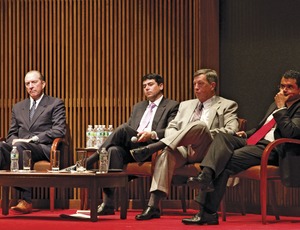
As the construction industry pulls out of the global recession and AEC firms search for a new generation of talent, finding the right path forward to new opportunities is critical, said speakers at ENR's Global Construction Summit, held in New York on April 11.
Attended by CEOs and senior executives of some of the world's leading engineering and construction firms, the event reminded attendees of the importance of the construction industry that represents 10% of global GDP and generates $5 trillion in economic activity, as noted by Fluor Corp. CEO David Seaton, a keynote speaker. He said the firm's backlog now is 80% derived from global work.
Brazil, India and China continue to lead the way with opportunities, especially for building infrastructure and urbanization. But the challenges of competing with local firms are no less vexing. How will AEC firms meet demand and secure financing amid a chilled credit environment?
And don't write off the U.S. either, executives noted. "There's still a home-field advantage for U.S. firms for U.S. projects," said industry analyst Jamie Cook, a managing director at Credit Suisse.
The change facing the industry is truly historic and the lessons are clear. Some themes follow.
Global Outlook: Wait Until 2014
Financial Guru Andrew Busch—Watch Debt-to-GDP Ratios
In his keynote address, Andrew Busch, global currency and public policy strategist for BMO Capital Markets, told the audience that sluggish growth is the best the industry can expect this year as it climbs out of the worst recession in a generation. "Uncertainty is the watchword this year," he said, noting that election- year politics are hampering bipartisan deals to reduce the country's debt.
Between the Supreme Court's review of the legality of the federal health-care law and a lack of clarity on rule-making with the Dodd-Frank financial regulation bill, companies are holding off on making investments or new hiring.
Plus, "states are broke," Busch said. "There are lots of opportunities for [public-private partnerships] to do some things. But it really takes a focus of that state to be willing to do it. We're just not there yet for making it a friendly environment." Busch's outlook is to wait until 2014.
Wall Street’s View—Investors See E&C Growth But Worry About Risk, Corruption
Analysts of the industry's publicly traded firms say investors see potential in the E&C sector but with caveats. Avram Fisher, analyst for BMO Capital Markets, questioned whether U.S. firms can compete with global companies in meeting the demand for labor and technical talent.
Credit Suisse's Cook said investors are concerned about foreign corrupt practices and whether firms are shouldering too much project risk. She noted movement in P3 infrastructure work, but "it's not big enough to move the needle where I get excited."
KeyBanc Capital Markets analyst Tahira Afzal said projects would continue to get bigger. "In the U.S., at least, with so much approval required, it's better to build 2X than X," she said, referring to larger projects.
But Fisher noted the "critical importance" of financial liquidity in the market. "That's when construction happens," he said.





Post a comment to this article
Report Abusive Comment